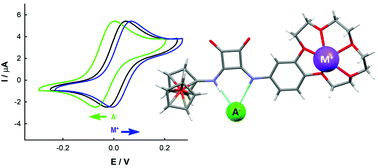Squaramide based ion pair receptors possessing ferrocene as a signaling unit†
Abstract
We synthesized ion pair receptors 1 and 2 consisting of a benzocrown ether cation binding site and a ferrocene-supported squaramide anion binding domain and compared their binding ability with anion receptor 3, lacking a crown ether unit, using spectroscopic, spectrophotometric, and electrochemical measurements in acetonitrile solution. All receptors were obtained in a modular fashion by sequential amidation of dimethyl squarate with corresponding amines, which allows for the simple introduction of a ferrocene unit and enables them to act as sensors. We found that ion pair receptors 1 and 2 recognized the tested anions more strongly in the presence of cations, whereas the homotopic anion receptor 3 was unable to bind sodium or potassium salts more strongly than tetrabutylammonium salts. This enhancement in anion binding was attributed to a cation complexation induced alteration in the nature of the phenyl ring substituents, directly linked to the squaramide anion binding site, changing from electron-donating to more withdrawing. Solid state X-ray measurements support this design principle of the receptors and reveal strong coordination of anions and cations to the corresponding binding domains. In both 1·NaCl and 2·KCl systems, organic moieties linked by the cations form 1-D polymeric structures in the crystal lattice. However, in the case of the 2·NaCl complex the polymers’ shape and orientation result in the formation of porous crystals with approximately 12% of the space unoccupied. Electrochemical measurements showed when the ion pair receptors (but not the anion receptor) were pretreated with sodium or potassium cations, the addition of anions resulted in greater changes in oxidation and reduction potentials compared to the addition of anions to the same receptors in the absence of cations. Overall, the study demonstrates that squaramides offer a convenient platform for constructing ion pair sensors in modular fashion by varying the cation binding site and reporters. This opens up the possibility of recognizing salts in real life scenarios where simultaneous binding of anions and cations is needed.



 Please wait while we load your content...
Please wait while we load your content...